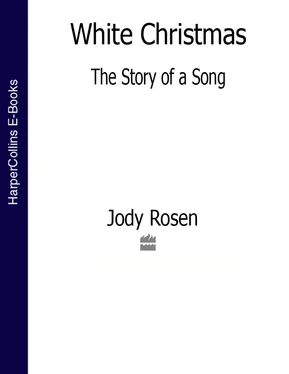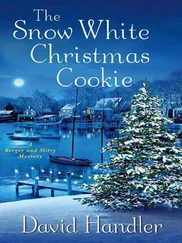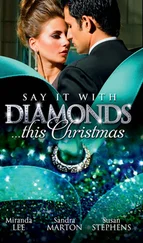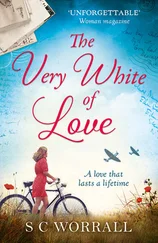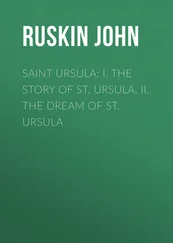Dedication Dedication Dedication 1. Introduction: The Hit of Hits 2. The Best Song Anybody Ever Wrote 3. Beverly Hills, L.A. 4. No Strings 5. Good Jewish Music 6. The Voice of Christmas 7. A War Tonic 8. Let It Snow 9. Old Songs Notes Index Acknowledgments About the Author About the Publisher To my parents
1.
Introduction: The Hit of Hits
2.
The Best Song Anybody Ever Wrote
3.
Beverly Hills, L.A.
4.
No Strings
5.
Good Jewish Music
6.
The Voice of Christmas
7.
A War Tonic
8.
Let It Snow
9.
Old Songs
Notes
Index
Acknowledgments
About the Author
About the Publisher
1
Introduction: The Hit of Hits
God gave Moses the Ten Commandments and then
He gave Irving Berlin … “White Christmas.”
—PHILIP ROTH,
Operation Shylock
They say a hanging man hears gorgeous music. Too bad that I, like my father, unlike my musical mother, am tone-deaf. All the same, I hope that the tune I am about to hear is not Bing Crosby’s “White Christmas” … Goodbye, cruel world!
—KURT VONNEGUT,
Mother Night
IRVING BERLIN was born in the nineteenth century and nearly outlived the twentieth. During the last several of his 101 years, Berlin faced a peculiar indignity: watching the copyrights expire on his earliest published songs. His ownership of those songs had been as tightfisted as the law would permit; he frostily refused permission to reprint his lyrics even to friends working on fawning tributes. Now the songs were leaving him: in 1982, “Marie from Sunny Italy,” his first published number, written when Irving Berlin was still Izzy Baline, a nineteen-year-old singing waiter in a Chinatown saloon; in 1984, “My Wife’s Gone to the Country (Hurrah! Hurrah!),” his first hit; in 1986, “Alexander’s Ragtime Band,” his career-making smash, whose clarion opening line—“Come on and hear”—announced not just the arrival of a national troubadour but a young country’s liberation from Victorianism and swaggering emergence into the century it would claim as its own.
The old man may have grieved the loss of his songs to the public domain, but much of his catalog had made that journey years before, migrating from Tin Pan Alley straight into national lore. He was born in Siberia, yet seemed to have a direct channel to the American imagination, yanking song after song out of the collective unconscious and returning them to his adopted country as beguiling reflections of its hopes, myths, and passing fancies. He strove to write, he said, “in the simplest way … as simple as writing a telegram.” In so doing, he filled the American Songbook with pop standards that sound as inevitable as folk songs; his songs are definitively twentieth-century things—“a Berlin ballad” appears in Cole Porter’s “You’re the Top” alongside a Waldorf salad and Mickey Mouse—yet they strike us as timeless, anonymous. We recognize George Gershwin’s musical signature in the bluesy grandeur of “Summertime” and “The Man I Love”; the droll, debonair voice of “Too Darn Hot” and “Miss Otis Regrets” is unmistakably Porter’s own. But in Berlin’s most celebrated songs—“Alexander’s Ragtime Band,” “A Pretty Girl Is Like a Melody,” “Always,” “Blue Skies,” “Puttin’ On the Ritz,” “How Deep Is the Ocean?” “Easter Parade,” “Cheek to Cheek,” “Let’s Face the Music and Dance,” “God Bless America,” “There’s No Business Like Show Business”—Berlin is invisible. It was not an insult when Alec Wilder, in his landmark study of American popular song, declared himself at a loss to describe stylistic common denominators in the songwriter’s vast output.
Berlin’s most famous song, by far the most valuable copyright in his (or anyone else’s) catalog, is “White Christmas.” But as I discovered in writing this book, it may be the Berlin hit least associated with him. Everyone I spoke to about “White Christmas” knew the song; everyone had Bing Crosby’s dulcet, definitive recording lodged in his mind’s ear. Yet few knew who composed it. This wasn’t true just of my contemporaries, who like me had grown up with hip-hop and rock ’n’ roll and whose only exposure to Irving Berlin may have been Taco’s synth-pop travesty of “Puttin’ On the Ritz.” I met avowed Berlin fans who not only were unaware that the man had written the tune, but could hardly comprehend that it had been written at all. They assumed “White Christmas” was as old as the hills, its creator as ancient and unknown as the composer of “God Rest Ye Merry Gentlemen.”
But “White Christmas” is a pop song: you could call it the pop song. Berlin liked to brag that the number “was a publishing business in itself,” a rare instance of the songwriter—no slouch at trumpeting his successes—selling himself short. “White Christmas” is the biggest pop tune of all time, the top-selling and most frequently recorded song: the hit of hits. It is a quintessentially American song that the world has embraced; among the untold hundreds of “White Christmas” recordings are versions in Dutch, Hungarian, Japanese, Swahili, and, in a knowing nod to its creator’s pedigree, Yiddish. Sales of “White Christmas” records have topped 125 million copies.
Bing Crosby’s original version on Decca Records remains a music industry landmark. For over fifty years it stood as the best-selling record in history. Introduced in the 1942 film Holiday Inn (it won the Academy Award for Best Song), Crosby’s “White Christmas” held first place on the Hit Parade countdown for a record ten consecutive weeks; it would reenter the survey every December for the next twenty years (excepting 1953), spending thirty-eight weeks in the top spot and an unprecedented eighty-six weeks on the chart. All told, Crosby’s “White Christmas” has sold over 31 million copies; it was unseated from its place in the Guinness Book of World Records as the all-time top single only by Elton John’s Princess Diana tribute, “Candle in the Wind ’97.” (Crosby’s record reentered the British charts for two weeks the next year—forty-five years after its initial release.)
Popular culture is infatuated with novelty, and pop music is particularly unsentimental, ruthlessly turning today’s superstar into tomorrow’s one-hit wonder, forever seeking refreshment in new styles, new sounds, the next big thing. Once a year, though, the Christmas season brings songs from several centuries back to jostle for airtime with the latest hits. “White Christmas” is a newcomer to the Christmas canon—the composer of “Joy to the World!” beat Berlin to the punch by at least two hundred years—but in the decades since its appearance, it has become the most performed of all seasonal songs: the world’s favorite Christmas carol. To this day, it continues to generate tens of thousands of annual record and sheet music sales. The Muzak versions that fill the nation’s malls each December should alone be enough to pile-drive “White Christmas” into the consciousness of unnumbered future generations of shoppers.
Although Crosby’s remains the signature version, singers won’t leave “White Christmas” alone: every year brings new versions by performers that run the musical gamut, from the Mormon Tabernacle Choir to the German heavy metal band Helloween. The list of “White Christmas” performers includes many of the most famous names in twentieth-century popular music: Bing Crosby, Louis Armstrong, Frank Sinatra, Ella Fitzgerald, Nat King Cole, Charlie Parker, Fats Domino, Elvis Presley, Aretha Franklin, the Beach Boys, Smokey Robinson and the Miracles, the Supremes, the Temptations, the Four Tops, the Jackson Five, Willie Nelson, Bob Dylan, Barbra Streisand, Bob Marley and the Wailers, Al Green, U2. Berlin’s melody has been reimagined as a stuttering punk anthem; as Wagnerian Sturm und Drang with a chorus of thousands wailing in the background; as a loping country ballad; as a string of quicksilver bop improvisations; as a thudding house track—a carol for an Ibiza Christmas. Otis Redding wrung new pathos from the old song, recasting it as a Memphis soul ballad; Michael Bolton did a laughable Otis Redding imitation and recorded what may be the most overwrought “White Christmas” of them all (and consider the competition). Is there another song that Kenny G, Peggy Lee, Mantovani, Odetta, Loretta Lynn, the Flaming Lips, the Edwin Hawkins Singers, and the Backstreet Boys have in common? What other tune links Destiny’s Child, The Three Tenors, and Alvin and the Chipmunks; Perry Como, Garth Brooks, and Stiff Little Fingers; the Reverend James Cleveland, Doris Day, and Kiss?
Читать дальше
